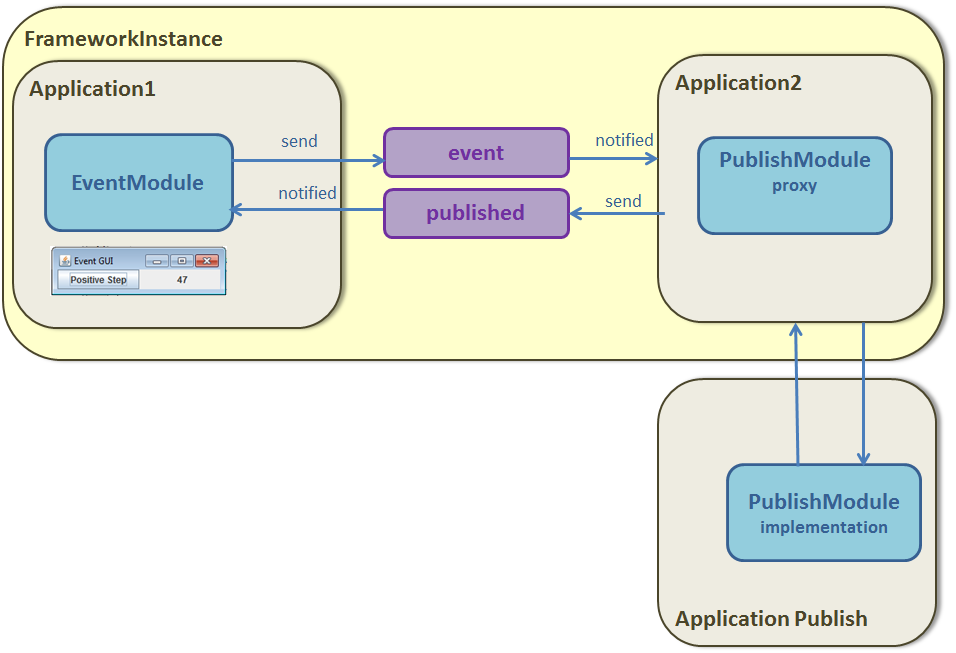Home
Categories
Dictionary
Glossary
Download
Project Details
Changes Log
What Links Here
FAQ
License
Autodescripted modules tutorial
1 Overview
2 Architecture
3 Specification of the autodescripted module
3.1 Autodescripted module application definition
3.2 Services and types definition
3.3 Code of the PublishModule
3.4 Content of the Jar file
4 Usage of the autodescripted module
5 See also
2 Architecture
3 Specification of the autodescripted module
3.1 Autodescripted module application definition
3.2 Services and types definition
3.3 Code of the PublishModule
3.4 Content of the Jar file
4 Usage of the autodescripted module
5 See also
The first tutorial presented the coding and configuration of a very simple system with two modules. In this tutorial, we will change the definition of one of the modules to encapsulate it as an autodescripted module.

The Services:
To be able to get the auto-description of the module, we will create a Manifest with the following attributes:
Overview
In the first tutorial, we had two modules:- The
PublishModulemodule increments or decrements a value cyclically - The
EventModulemodule allows to click on a toggle to set if the first module should increment or decrement the value, and shows the value
PublishModule as an autodescripted module.
Architecture
Rather than directly defining the implementation of thePublishModule in the applications definition, we will point to a jar file specifying the module implementation in its manifest.
Specification of the autodescripted module
Autodescripted module application definition
The original description of the application containing ourPublishModule module was:<applications> ... <application name="publishAppli"> <deployment> <lib url="samplesPublish.jar" /> </deployment> <modules> <module name="PublishModule" > <implementation path="org.da.samples.protoframework.publish.PublishModule" > <initEntryPoint method="init" /> <defaultReceiveEntryPoint method="subscribe" /> <defaultSendEntryPoint method="publish" /> </implementation> <interfaces> <eventReceived service="event"/> <cyclic service="published" frequency="200ms" attach="attach"/> </interfaces> </module> </modules> </application> <applications>We will keep the same definition, but:
- We don't need to set the application deployment in our case, because the application description descript what is in the jar file we are
- We also don't need to enclose our
PublishModulemodule, because an autodescripted module only cotnains one module
<application name="publishAppli"> <modules> <module name="PublishModule" > <implementation path="org.da.samples.protoframework.publish.PublishModule" > <initEntryPoint method="init" /> <defaultReceiveEntryPoint method="subscribe" /> <defaultSendEntryPoint method="publish" /> </implementation> <interfaces> <eventReceived service="event"/> <cyclic service="published" frequency="200ms" attach="attach"/> </interfaces> </module> </modules> </application>
Services and types definition
The services and type does not need to change from the first tutorial.The Services:
<services> <event name="event" id="1" > <data name="event" type="bool" /> </event> <publish name="published" id="2" > <data name="value" type="int" /> </publish> </services>The Types:
<types> <simpleType name="bool" baseType="boolean" /> <simpleType name="int" baseType="int" /> </types>
Code of the PublishModule
The code does not need to change at all from the first tutorial:public class PublishModule { private ServiceInstance eventService = null; private ServiceInstance publishService = null; private int count = 1; private int step = 1; public void init(Module module) { eventService = module.getService("event"); publishService = module.getService("published"); } public void subscribe(ServiceInstance service) { boolean evt = eventService.getData("event").getValueAsBoolean(); if (evt) { step = -1; } else { step = 1; } } public void publish(ServiceInstance service) { publishService.setDataIntValue("value", count); count += step; publishService.invoke(); } }
Content of the Jar file
We just have to add a Manifest to the already existingsamplesPublish.jar jar file:To be able to get the auto-description of the module, we will create a Manifest with the following attributes:
Modules: applications.xml Services: services.xml Types: types.xml
Usage of the autodescripted module
The original description of the applications configuration was:<applications> <application name="eventAppli" > <deployment> <lib url="samplesEvent.jar" /> </deployment> <modules> <module name="EventModule" > <implementation path="org.da.samples.protoframework.event.EventModule" > <initEntryPoint method="init" /> <defaultReceiveEntryPoint method="subscribe" /> </implementation> <interfaces> <eventSend service="event" attach="attach"/> <subscribe service="published" /> </interfaces> </module> </modules> </application> <application name="publishAppli" > <deployment> <lib url="samplesPublish.jar" /> </deployment> <modules> <module name="PublishModule" > <implementation path="org.da.samples.protoframework.publish.PublishModule" > <initEntryPoint method="init" /> <defaultReceiveEntryPoint method="subscribe" /> <defaultSendEntryPoint method="publish" /> </implementation> <interfaces> <eventReceived service="event"/> <cyclic service="published" frequency="200ms" attach="attach"/> </interfaces> </module> </modules> </application> </applications>To use our newly created autodescripted module, we now have a much more simple description for the
PublishModule module:<applications> <application name="eventAppli" > <deployment> <lib url="samplesEvent.jar" /> </deployment> <modules> <module name="EventModule" > <implementation path="org.da.samples.protoframework.event.EventModule" > <initEntryPoint method="init" /> <defaultReceiveEntryPoint method="subscribe" /> </implementation> <interfaces> <eventSend service="event" attach="attach"/> <subscribe service="published" /> </interfaces> </module> </modules> </application> <application name="publishAppli" > <deployment> <lib url="samplesPublish.jar" /> </deployment> </application > </applications>
See also
- Tutorials: This tutorial reuse the first tutorial, but the two modules are in two different framework instances
- First tutorial: The first tutorial present the coding and configuration of a very simple system with two modules
- Autodescripted modules: This article explains how to define and instanciate generic Java modules
×
![]()
Categories: tutorials